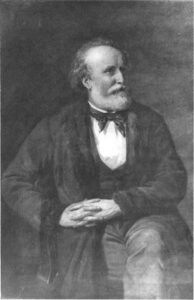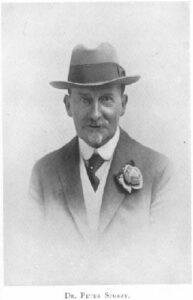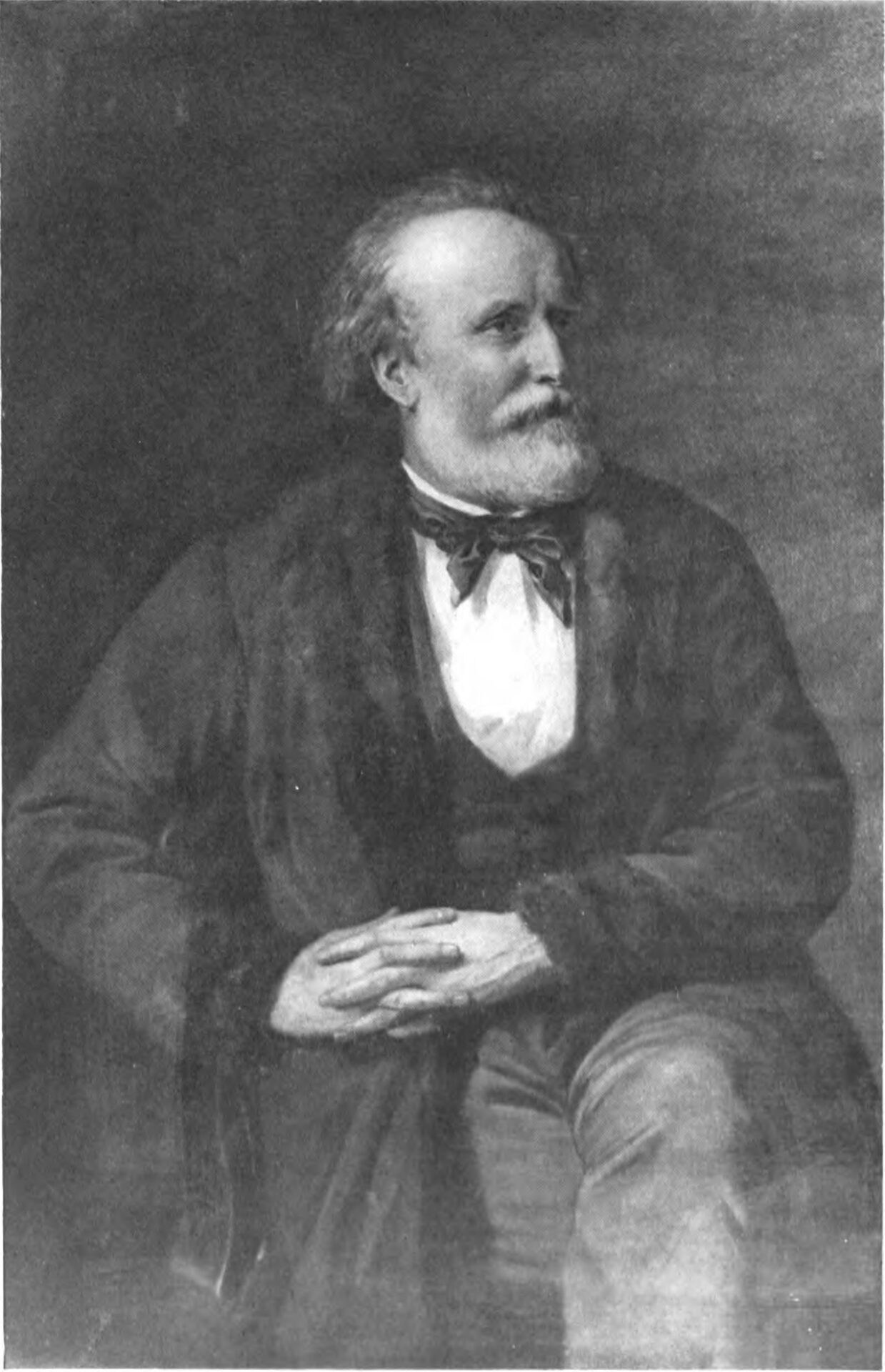
Peter Stuart
Image source: The Life of Peter Stuart, the “Ditton Doctor”
Peter Stuart J.P. (1815 – 21 September 1888), known as the the “Ditton Doctor,” was a Liverpool shipowner, merchant, and a lay homeopath, he devoted one afternoon a week for forty years to dispense homeopathic medication to the poor. It is estimated that during his lifetime he prescribed for some 300,000 to 350,000 people.
Peter Stuart founded the firm Stuart and Douglas on the Brass River in West Africa, and he banished the slave trade from that region: “he was proud of the fact that he never made a cent out of the slave trade; a form of commerce which he detested.”
Peter Stuart was a friend of John Bellamy, John Epps, Giuseppe Garibaldi, George Jacob Holyoake, Lajos Kossuth, William James Linton, Edwin Longsden Long, Giuseppe Mazzini, Felice Orsini, Thomas Simpson, James John Garth Wilkinson and many others, and he corresponded directly with Samuel Hahnemann, and Clemens Maria Franz Baron von Boenninghausen. Peter Stuart was also fascinated by phrenology, and he chose his employees based on this discipline.
Peter Stuart was on the Management Committee of the English Homeopathic Association in 1849, alongside William Henry Ashurst, John Burnett, Edward Cronin, Paul Francois Curie, A. O. Deacon, Robert S. Dick, George Napoleon Epps, John Epps, Robert Frith, Joseph Glover, Robert Grosvenor, George Hayes, Thomas H. Johnstone, Henry Kelsall, John Miller, William MacOubrey, Henry P. Osman, Charles Thomas Pearce, William Perkins, George K. Prince, James Stansfeld, Allan Templeton, James Thomson, William Warne, and James Wilson.
Peter Stuart was born on Merseyside during the Napoleonic Wars. His father, also Peter Stuart, was a business man residing in Italy, who joined the Royal Navy and served under Horatio Nelson at the Battle of Trafalgar. Afterwards, Peter Stuart senior settled in Liverpool and prospered as a master carpenter.
Peter Stuart the younger trained as a cooper, spending his free time in study. He was personally involved in some of the key issues of the age and took up the causes of Italian unification, the abolition of slavery, and the abolition of the Corn Laws.
Peter Stuart had been a friend of homeopathic physician John Epps since as early as 1843, when they were both involved in the campaign around the Corn Laws.
Though Peter Stuart had been corresponding directly with Samuel Hahnemann since the early 1830s, and with whom he was on intimate and friendly terms, it would be John Epps, who would become the homeopathic practitioner of Stuart’s sister, who taught Peter Stuart the practice of homeopathy:
Under the guiding hand of his friend Dr. Epps, Peter Stuart commenced the study of homœopathy, and in a comparatively short period he obtained a sound knowledge of the science…..Peter Stuart possessed a type of brain which enabled him to undertake an enormous amount of work, of various kinds, and yet to concentrate and master each particular part. In this way he approached the study of homoeopathy, and after a while treated one or two ailing animals at his home in Ditton, near Widnes. His results were good, and he extended homoeopathic principles to the members of the household, and gave them personal attention whenever they required medical help. His record for over a period of two score years provides conclusive proof that he knew a great deal more of physical ailments than many qualified doctors of his time. The fact that he had treated his household, and one or two others living in the Ditton district, soon became known, and farmers from miles around came to Mr. Stuart for treatment. His services were freely given, and it is to his credit that he readily gave his advice and supplied medicine without any charge whatsoever. His reputation as the “Ditton Doctor” spread for many miles….
After giving advice and medicine for some few years, Peter Stuart left Ditton to take up his residence at Seaforth, and his fame had spread over a large part of Lancashire, and people followed him to his new home in Seaforth, where they were given advice and medicine. It was a pleasure to him to do this and to alleviate the suffering of the thousands who visited him. These facts are all the more remarkable when one remembers that he had a large West African business involving the handling of some 30 to 40 vessels, as well as other interests, to take up his time. So highly did the people esteem the advice and medicine of Peter Stuart that the members of a Catholic Convent, situated not far from Ditton, regularly asked his help in cases of sickness, and even church dignitaries were amongst his followers.
His aim, however, was not to minister to those in good circumstances in life, but to look after the wants of those less fortunately placed, devoting one day a week to the work….. It is estimated that during his lifetime he prescribed for some 300,000 to 350,000 people. One cannot help but think that medical science lost a distinguished patron through Peter Stuart not being qualified. He had many traducers, because, one has to remember, that about the time under review the medical profession was almost entirely allopathic, and only the fact that Peter Stuart made no charge whatever for his advice or medicine saved him from prosecution at the hands of the medical authorities.
Peter Stuart was a profound and generous Patron of homeopathy, and he also procured many homeopathic relics, which his sons Mazzini and Orsini Stuart donated to the Hahnemann House Museum in Powis Place, adjacent to the London Homeopathic Hospital:
“…Through the kindness of the family of the late Mr. Peter Stuart, of Liverpool, and William Leaf, of London, the cause of Homeopathy in this country owes more than the the country is ever likely to know. On the death of Melanie Hahnemann, Mr. Peter Stuart, with most laudable hero worship, secured a number of Hahnemann relics….”
Peter Stuart also took a close interest in European politics, supporting Giuseppe Garibaldi, Giuseppe Mazzini in every way possible, and involving himself in their campaigns for Italian Unification from the very beginning and lasting well after Unification was achieved. Giuseppe Mazzini was godfather to Stuart’s youngest son, who was named after the Italian.
Peter Stuart first met Anglo-American artist and political reformer William James Linton in 1849 when he stepped forward to support Linton and Mazzini’s efforts to protect an unfortunate boat load of Polish refugees who had recently docked in Liverpool. Peter Stuart found them accommodation in a disused soap factory, and supplied them with money and food, and the local population brought them water and straw to sleep on. It would be through Peter Stuart that Linton and his wife, the journalist and author Eliza Lynn Linton, would meet John Epps and James John Garth Wilkinson.
In December 1840, Peter Stuart married Ellen Moss (1820 – 1887) in Liverpool. They had nine children: Selina, Rachael Ann, Hahnemann, Cromwell, Milton, Peter, Bellamy, Orsini, and Mazzini. The two youngest, Orsini (1858 – 1929) and Mazzini Stuart (1862 – 1937), donated their father’s priceless collection of Hahnemann relics, along with the building, Hahnemann House, on Powis Street, London, to what would become the Hahnemann House Trust.
Peter Stuart died on 21 September 1888 at his home, Elm House, in Seaforth, aged 73. His youngest son, Mazzini Stuart, wrote an extensive biography of his father, reproduced on the website of Homéopathe International by Francis Treuherz and Sylvain Cazalet.
Of Interest:
Henry Turner‘s 1856 book The Lung Disease of Cattle; or pleuro pneumonia cured by homeopathy, discussed some work done by William Haycock, who first noticed this disease in 1842. George Edward Allshorn, Charles William Luther and John Rush also had experience treating this disease. Farmers had been losing thousands of cattle to this disease, Charles W. Luther estimated that 6 out of every 10 cattle so affected could be cured. In Liverpool, Peter Stuart also used homeopathy at this time and treated up to 180 cows suffering from this disease, saving about 130 of them.
 Peter Stuart L.R.C.P. L.R.C.S. L.M. (1853 – 12 April 1917) was a son of Peter Stuart, who practiced as a pure Hahnemannian homeopath. Peter Stuart received his medical education at the University of Edinburgh and was associated with the Liverpool Hahnemann Homeopathic Hospital where he served as a physician. In 1892 he joined the British Homeopathic Society, and was a member of the Liverpool Branch of the Society. Peter Stuart purchased the former house belonging to John James Drydale, 36A Rodney Street, Liverpool, widely regarded as the centre for homeopathy in the area. In 1887, he married Nottingham-born Edith Kate Simpson (1863 – 1933). They had two sons, Francis Ronald (1888 – 1973) and Captain Peter Carrall Dudley Stuart, R.A.F. (1894 – 1918).
Peter Stuart L.R.C.P. L.R.C.S. L.M. (1853 – 12 April 1917) was a son of Peter Stuart, who practiced as a pure Hahnemannian homeopath. Peter Stuart received his medical education at the University of Edinburgh and was associated with the Liverpool Hahnemann Homeopathic Hospital where he served as a physician. In 1892 he joined the British Homeopathic Society, and was a member of the Liverpool Branch of the Society. Peter Stuart purchased the former house belonging to John James Drydale, 36A Rodney Street, Liverpool, widely regarded as the centre for homeopathy in the area. In 1887, he married Nottingham-born Edith Kate Simpson (1863 – 1933). They had two sons, Francis Ronald (1888 – 1973) and Captain Peter Carrall Dudley Stuart, R.A.F. (1894 – 1918).
Orsini Stuart (1858 – 1929), son of Peter Stuart, was a keen advocate of homeopathy, and he was on the Committee of the Liverpool Hahnemann Hospital. He was named in honour of Italian revolutionary and leader of the Carbonari secret society, Felice Orsini (1819 – 1858), a friend of his father.
Mazzini Stuart (1862 – 1937), son of Peter Stuart, was also a keen advocate of homeopathy. He was named in honour of Italian revolutionary and political leader Giuseppe Mazzini (1805 – 1872), a friend of his father. He:
…. was a keen homœopathist, and, in conjunction with his brother Orsini, is the donor of the freehold property known as Hahnemann House, which adjoins the London Homeopathic Hospital. In making a gift of Hahnemann House his idea was to provide an Hahnemann Museum, which would become a centre of interest to all Homeopathic doctors. He has also contributed a number of Hahnemannian relics, which form the basis of a permanent collection.



You mention Italy and i am just wondering if you knew where Peter was born. He was my 4th great granddad and i can not find anything much about him. And why he was in Italy in the first place, i have a lot of questions. One major one is, was he Italian?